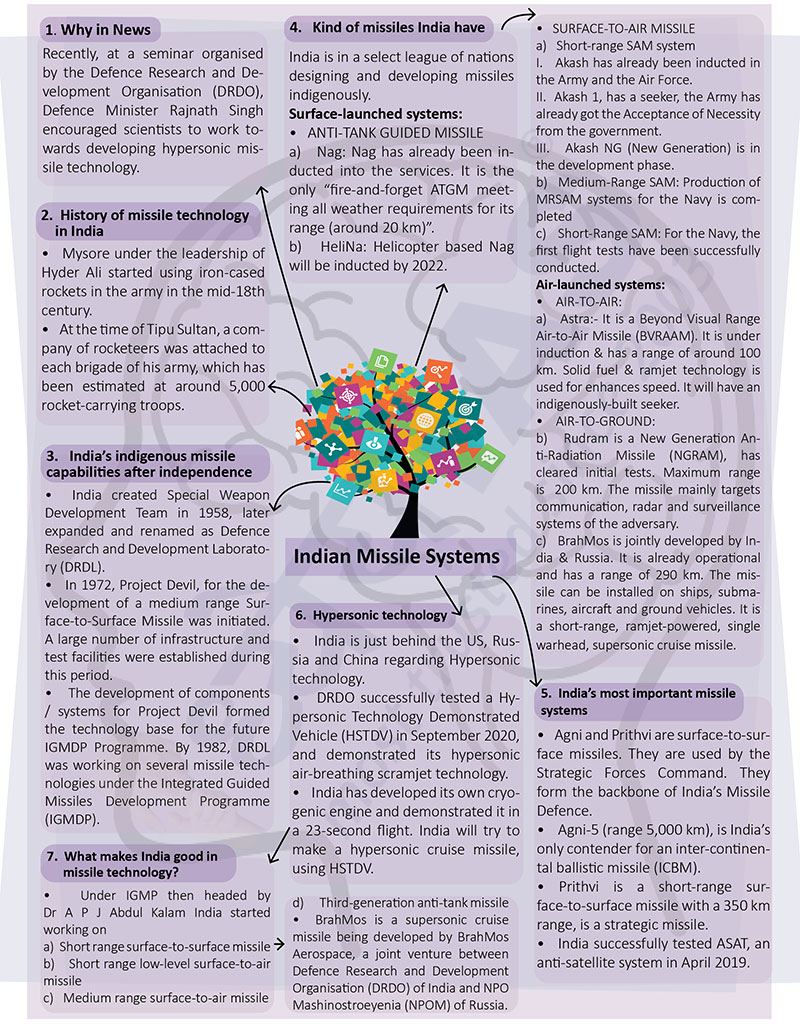Why in News?
- Recently, at a seminar organised by the Defence Research and Development Organisation (DRDO), Defence Minister Rajnath Singh encouraged scientists to work towards developing hypersonic missile technology.
History of missile technology in India
- Mysore under the leadership of Hyder Ali started using iron-cased rockets in the army in the mid-18th century.
- At the time of Tipu Sultan, a company of rocketeers was attached to each brigade of his army, which has been estimated at around 5,000 rocket-carrying troops.
India’s indigenous missile capabilities after independence
- India created Special Weapon Development Team in 1958, later expanded and renamed as Defence Research and Development Laboratory (DRDL).
- In 1972, Project Devil, for the development of a medium range Surface- to-Surface Missile was initiated. A large number of infrastructure and test facilities were established during this period.
- The development of components/ systems for Project Devil formed the technology base for the future IGMDP Programme. By 1982, DRDL was working on several missile technologies under the Integrated Guided Missiles Development Programme (IGMDP).
Kind of missiles India have
India is in a select league of nations designing and developing missiles indigenously.
Surface-launched systems:
ANTI-TANK GUIDED MISSILE
- Nag: Nag has already been inducted into the services. It is the only “fire-and-forget ATGM meeting all weather requirements for its range (around 20 km)”.
- HeliNa: Helicopter based Nag will be inducted by 2022.
SURFACE-TO-AIR MISSILE
a) Short-range SAM system
- Akash has already been inducted in the Army and the Air Force.
- Akash 1, has a seeker, the Army has already got the Acceptance of Necessity from the government.
- Akash NG (New Generation) is in the development phase.
b) Medium-Range SAM: Production of MRSAM systems for the Navy is completed
c) Short-Range SAM: For the Navy, the first flight tests have been successfully conducted.
Air-launched systems:
- AIR-TO-AIR:
- Astra:- It is a Beyond Visual Range Air-to-Air Missile (BVRAAM). It is under induction & has a range of around 100 km. Solid fuel & ramjet technology is used for enhances speed. It will have an indigenously-built seeker.
- AIR-TO-GROUND:
- Rudram is a New Generation Anti-Radiation Missile (NGRAM), has cleared initial tests. Maximum range is 200 km. The missile mainly targets communication, radar and surveillance systems of the adversary.
- BrahMos is jointly developed by India & Russia. It is already operational and has a range of 290 km. The missile can be installed on ships, submarines, aircraft and ground vehicles. It is a short-range, ramjet-powered, single warhead, supersonic cruise missile.
India’s most important missile systems
- Agni and Prithvi are surface-to-surface missiles. They are used by the Strategic Forces Command. They form the backbone of India’s Missile Defence.
- Agni-5 (range 5,000 km), is India’s only contender for an inter-continental ballistic missile (ICBM).
- Prithvi is a short-range surface- to-surface missile with a 350 km range, is a strategic missile.
- India successfully tested ASAT, an anti-satellite system in April 2019.
Hypersonic technology
- India is just behind the US, Russia and China regarding Hypersonic technology.
- DRDO successfully tested a Hypersonic Technology Demonstrated Vehicle (HSTDV) in September 2020, and demonstrated its hypersonic air-breathing scramjet technology.
- India has developed its own cryogenic engine and demonstrated it in a 23-second flight. India will try to make a hypersonic cruise missile, using HSTDV.
What makes India good in missile technology?
- Under IGMP then headed by Dr A P J Abdul Kalam India started working on
- Short range surface-to-surface missile
- Short range low-level surface-to-air missile
- Medium range surface-to-air missile
- Third-generation anti-tank missile
- BrahMos is a supersonic cruise missile being developed by BrahMos Aerospace, a joint venture between Defence Research and Development Organisation (DRDO) of India and NPO Mashinostroeyenia (NPOM) of Russia.








